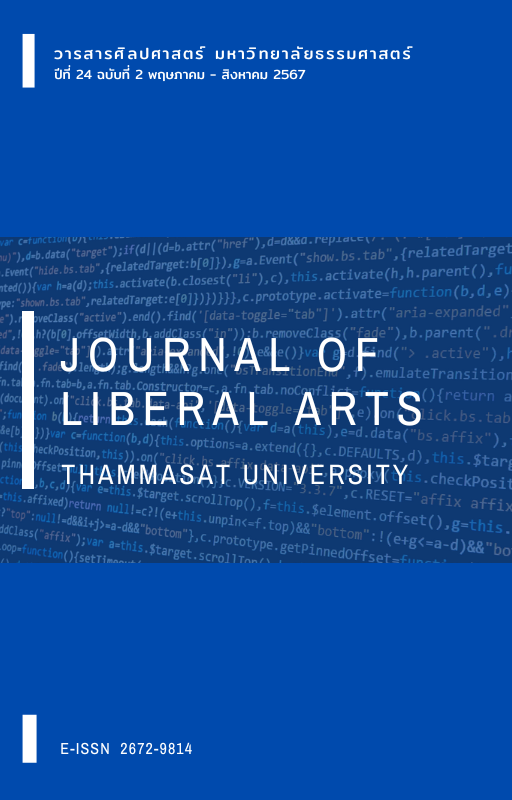Translating Japanese Passive Construction into Thai Language
Main Article Content
Abstract
This article investigates the translation of Japanese passive construction into Thai, identifying the types of construction employed. The analysis draws on data from Japanese literature and documentary writing, along with their Thai translations. The study uncovers a diversity of construction types, including the passive thùuk construction, intransitive construction, and stative verb construction. Functionally, these constructions may be categorized as either highlighting the subject of the sentence or demoting the role of the agent. The study also notes the use of constructions where the subject is the action initiator, such as active construction and resultative verb construction. This research elucidates the relationship between various Thai constructions and Japanese passive construction, deepening the understanding of trends in translation of Japanese passive construction into Thai.
Downloads
Article Details

This work is licensed under a Creative Commons Attribution-NonCommercial-NoDerivatives 4.0 International License.
References
ปฤณา มโนมัยวิบูลย์. (2547). การหลีกเลี่ยงประโยคกรรม “ถูก” ในเรื่อง แฮร์รี่ พอตเตอร์ ฉบับภาษาไทย [วิทยานิพนธ์ปริญญามหาบัณฑิต]. จุฬาลงกรณ์มหาวิทยาลัย.
พรพิลาส เรืองโชติวิทย์. (2524). ประโยครับในภาษาไทย [วิทยานิพนธ์ปริญญามหาบัณฑิต]. จุฬาลงกรณ์มหาวิทยาลัย.
รัฐพล ทองแตง. (2552). หน่วยสร้างประธานรับการกระทำในภาษาไทย [วิทยานิพนธ์ปริญญามหาบัณฑิต]. จุฬาลงกรณ์มหาวิทยาลัย.
ศิริมา ภิญโญสินวัฒน์. (2533). หน่วยสร้างภาษาไทยที่เทียบเท่ากับหน่วยสร้างกรรมวาจกภาษาอังกฤษในข่าวต่างประเทศผ่านดาวเทียม. [วิทยานิพนธ์ปริญญามหาบัณฑิต]. จุฬาลงกรณ์มหาวิทยาลัย.
อมรา ประสิทธิ์รัฐสินธุ์. (2549). หน่วยสร้างกรรมวาจก. ใน อมรา ประสิทธิ์รัฐสินธุ์ (บรรณาธิการ), หน่วยสร้างที่มีข้อขัดแย้งในไวยากรณ์ไทย หน่วยสร้างคุณานุประโยค หน่วยสร้างประโยคเติมเต็ม หน่วยสร้างกริยาเรียงและหน่วยสร้างกรรมวาจก (หน้า 174-273). จุฬาลงกรณ์มหาวิทยาลัย, ภาควิชาภาษาศาสตร์.
อัญชลี สิงห์น้อย วงศ์วัฒนา. (2556). หน่วยสร้างกรรมวาจกในภาษาไทย: การวิเคราะห์ในแนวไวยากรณ์หน้าที่นิยมแบบลักษณ์ภาษา. ภาษาและภาษาศาสตร์, 31, 1-34.
Katagiri, K. L., & Chawengkijwanich, S. (in press). A contrastive analysis of passive markers in Japanese and Thai: Factors influencing the use of passive. MANUSAYA: Journal of Humanities.
Kuroda, S. Y. (1979). On Japanese passives. In G. Bedell, E. Kobayashi, & M. Muraki (Eds.), Explorations in Linguistics: Papers in honor of Kazuko Inoue (pp. 305-347). Kenkyusha.
Prasithrathsint, A. (1983). The Thai equivalents of the English passives in formal writing: A case study of the influence of translation on the target language. Working papers in linguistics, 15(1), 47-68.
Shibatani, M. (1985). Passive and related constructions: A prototype analysis. Language, 61(4), 821-848.
Shibatani, M. (2006). On the conceptual framework for voice phenomena. Linguistics, 44(2), 217–269.
Ayako Nagura 倉綾子. (2011).「タイ語と日本語の受身文の対照研究―日本語受身文のタイ語への翻訳から―」.『思言: 東京外国語大学記述言語学論集』, 7, 169-176.
Ayako Shiba 志波彩子. (2009).「現代日本語受身文の体系:意味・構造的なタイプの記述から」[博士論文]. 東京外国語大学.
Ayako Shiba 志波彩子. (2015). 『現代日本語の受身構文タイプとテクストジャンル』. 和泉書院.
Ayako Shiba. 志波彩子. (2022). 「日本語学における受身構文」庵功雄 (編), 『日本語受身文の新しい捉え方』(pp. 1-26). くろしお出版.
Hisashi Noda 野田尚史. (1991).「文法的なヴォイスと語彙的なヴォイス」仁田義雄 (編),『日本語のヴォイスと他動性』(pp. 211-232). くろしお出版.
Kazuko Inoue 井上和子. (1976). 『変形文法と日本語・上』 大修館書店.
Kei Ishiguro 石黒圭. (2005). 『よくわかる文章表現の技術Ⅲ―文法編―』 明治書院.
Nihongokijutsubunpou Kenkyukai 日本語記述文法研究会. (2009).『現代日本語文法2』くろしお出版.
Sumire Goda 江田すみれ. (2019).「無対他動詞の受身と自動詞の関係―語義についての検討―」 日本語/日本語教育研究会(編), 『日本語/日本語教育研究』(pp.37-52). ココ出版.
Takashi Masuoka 益岡隆志. (1982). 「日本語受動文の意味分析」『言語研究』, 82, 48-64.
Takashi Masuoka 益岡隆志. (1991).「受動表現と主観性」『日本語のヴォイスと他動性』 くろしお出版.
Tasanee Methapisit タサニー メーターピスィット. (2000). 「タイ語の受動態と使役態の現れ方と動詞の分類」『言語・地域文化研究』, 6, 59-79.

